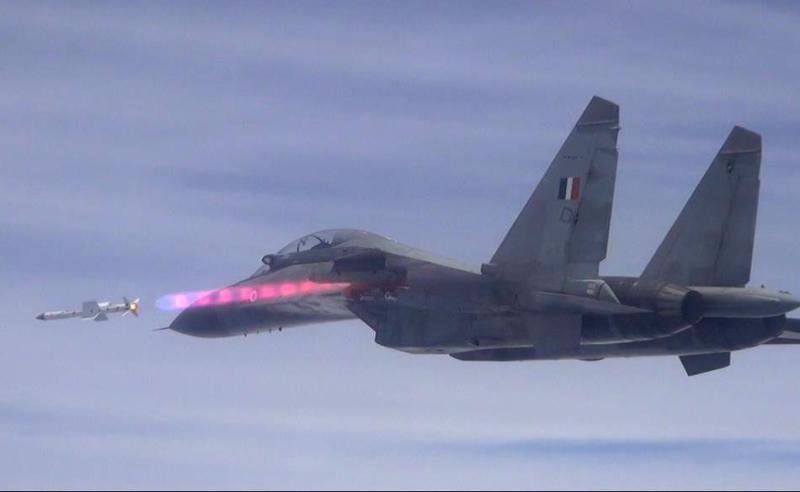Missile test ‘boom’ sends Digha scurrying for cover
Digha/Kolkata: The seaside towns of Digha and Tajpur broke into panic, with thousands of tourists and local residents coming out of their hotels and homes, after a military exercise to fire air-to-air missiles near the coastline broke the sound barrier and triggered sonic booms that shattered window panes and damaged building fac-ades on Saturday morning.
Clueless firemen and cops combed the two towns for a couple of hours, suspecting a terror attack, before it became clear that the trigger was a military exercise involving the indigenous Astra air-to-air missile from Russian-origin Sukhoi-30 MKI fighter aircraft.
It was not clear whether the sonic booms were created by the Sukhois — capable of travelling at Mach 2 (twice the speed of sound at high altitudes) — or the missiles that can achieve speeds of Mach 4.5, but the two loud booms in quick succession were enough to bring thousands of panic-stricken people on to the streets.
"There were two sounds within a couple of minutes around 11.10am. The second one was so loud that it could be heard at Tajpur as well. The whole coastline was shaken and people felt the vibrations inside hotel rooms," East Midnapore SP Alok Rajoria said.
It was only later in the evening that sources in the Indian Air Force confirmed that Astra missiles were being test-fired at the air-to-air firing range over the Bay of Bengal at the time when the booms were heard. Fighter aircraft operating out of Air Force Station Kalaikunda — about 100km from Digha — usually fly sub-sonic till they are 40-odd kilometres into the sea. However, during such trials, when missiles are fired at drones from various angles and speeds, it is possible for an aircraft to go supersonic closer to shore. The explosions may also have been caused by missiles that went supersonic after being fired.
The DRDO-developed Astra missile is likely to be inducted into the IAF later this year.
It was only recently that an indigenous seeker was developed for Astra. The Beyond Visual Range (BVR) range missile can hit targets between 20 and 80 km away, depending on the propulsion system used. The missiles will be fitted to all varieties of fighter aircraft available with the IAF after undergoing trials from Su-30 MKIs.
The impact, however, was terrifying for those on the ground who did not know what was happening (which included the state administration). "There are 80 students in my school. The explosions were so loud that the children started crying. We were rattled and didn't know what to do so we took all the children out of the classrooms. Later, officials from the Digha coastal police station told us that there was nothing to worry and the children went back to their lessons," Gangadharpur Primary School assistant teacher Malati Mishra said.
Rajarhat resident Surajit Mandal, in Digha with his family, rushed out thinking there was an explosion in the hotel where they were staying or the one next door. "I had just entered the hotel and then heard the noise. I ignored the first one but the second one was so loud that I was shaken. I took my family out of the hotel," he said.
Salt Lake resident Ramashis Singh was enjoying the sea with his two friends when they heard the noise. "We came out of the sea wondering whether a terror attack had taken place. There was another explosion within two minutes. We could not see anything. There was no smoke or debris but the sound was scary," Singh said.
The incident occurred a day after intelligence inputs of possible sea-borne terror strikes along the Bengal and Odisha coasts went public. The district administration reacted fast and despatched teams to find the source of the "explosions". Personnel from the Digha coastal police station scoured the waters in speed boats and launches in search of explosive material and officials went around streets and beaches with loudhailers, urging people to remain calm and not venture out to sea for the time being.
"Our suspicion turned to the interim test range at Chandipur in Odisha — about 100 km away by road — where missiles and rockets are tested after we found no evidence of explosions on land or in the sea. We suspected some missiles or rockets could have misfired and landed in the sea close to Digha, causing the explosions," a senior police officer said.
The Defence Research and Development Organisation (DRDO) confirmed no tests were scheduled from Chandipur or
Wheeler Island on Saturday morning. Usually, a notice is issued to the air traffic control in Kolkata by the DRDO prior to such exercises, for diversion of flights from the east coast where the navigational routes to south India lie.
"The notice to airmen (NOTAM) was for 3 p.m. when the airspace was sealed for missile tests. A DRDO official was at the Kolkata airport to coordinate the closure of the airspace. Flights to Chennai, Bengaluru, Hyderabad and Bhubaneswar were diverted via west, requiring an additional flight tine of 8-15 minutes," an ATC source in Kolkata said.
http://timesofindia.indiatimes.com/...-scurrying-for-cover/articleshow/60239567.cms












